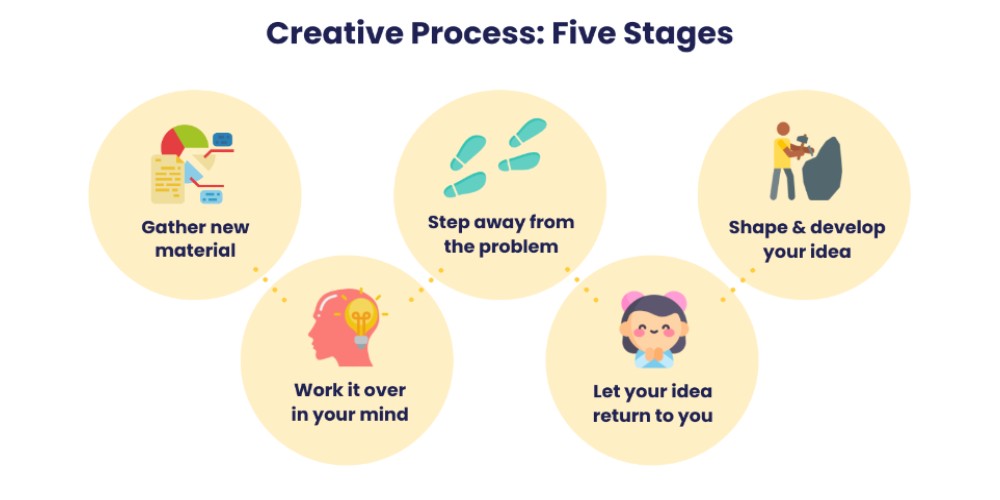Creativity makes our world a better place. How do you think significant discoveries were made? How do evolutionary ideas or even just new approaches appear? They all rely on the creative process as much as on problem-solving and critical thinking skills.
Creativity pushes humanity forward. It helps the gears of progress spin faster. And it makes people’s lives more comfortable and exciting.
That’s why we should improve our creativity since childhood. Teachers should encourage children to use imagination more and offer activities to develop creativity in their classrooms. Besides, we should understand how to be more creative.

Today, we’ll learn more about different creative process examples. Custom Writing experts will share exercises for improving your skills. You’ll be able to use them while studying, working on a project, or just going about your everyday life. This is easy! So, see how to boost your creativity here.
1. 💡 Creative Process: Definition
Creative process occurs when old ideas are connected and transformed to generate a new approach to old concepts. It is wrong to discuss a creative process as a road to new ideas that have never been invented before. Creativity is more about finding new approaches to old problems in life.
Creativity stands among the skills essential to success in art, entrepreneurship, tutoring, and many other domains. The following five steps can teach anyone how to be a creative person.
- Collect new information. Everything starts with learning. First, you need to focus on the specific information immediately related to your assignment. Then try to amplify your scope of knowledge to the related and more general topics.
- Think about the information from different points of view. Try uniting various facts, juxtaposing them, and looking for errors.
- Put the assignment away for a while. Some brain processes take place only when we are relaxing or sleeping. Do something inspiring for a while. Go for a walk, meet with your friends, or read some fiction.
- Return to the problem. When you have restored your energy, the problem will come in a new light. All insights happen here.
- Collect and analyze the feedback. Then share your ideas with the people you trust and respect. Ask them to criticize the products of your thoughts. In this conversation, you will find out what you have missed.
2. 🔨 Creativity Techniques
2.1. Improvisation
Improvisation involves writing, speaking, and composing without prior preparation. This process usually opens up new ways of doing things. It helps with the discovery of original thought and practice patterns, new structures, and so on. It also improves the development of creative skills.
Improvisation is useful in numerous fields. For instance, it can help if you want to learn how to be more creative in writing. Let’s say, writing an essay. By enforcing various limits on you as a writer, you’ll have to write by stream of consciousness, without judgment of your work. This helps you overcome writer’s block and enhance your writing instinct. It also improves flexibility in writing and acts as a creative booster in general.
2.2. Brainstorming
Brainstorming is a method of generating ideas in a group. It requires several people to work together, generate ideas, and solve problems. The method follows the principle of suspending judgment.
Brainstorming can be used in any sphere imaginable, anywhere there’s a need to come up with new and fresh ideas. It’s helpful in marketing, writing a screenplay, or working on a project. It can be any type of project for a school or university or even the process of developing essay ideas.
Brainstorming usually goes as follows:
- Get together in a group.
- Write down the initial topic for everyone to see. The more specifically you define the issue and state the problem, the better outcome you’ll have.
- Make sure that everyone understands the idea.
- Set the rules:
- Accept all ideas without any criticism.
- Aim for a significant number of ideas without limits. The more, the better. Otherwise, judgment will ensue.
- Don’t break the flow, and avoid censoring ideas.
- Save all discussion for later. Also, if possible, try to create ideas that are linked to previous ones.
- Have one person responsible for enforcing the rules. You should also have someone writing down the ideas (it can be the same person).
- Start coming up with ideas. It can go two ways:
- Everyone can share their views at any time, without structure
- Ideas can be generated by taking turns around the table, with the option to pass.
- Make final clarifications and conclusions. Group similar ideas and keep the rest as is. Decide what to do next based on the ideas you’ve gathered.
2.3. Lateral Thinking
This technique involves problem-solving through a creative and indirect approach. The key is to use reasoning that might not be obvious at first. The method also includes ideas that may fall outside the boundaries of conventional step-by-step logic.
One of the brightest examples of creative thinking of this kind is the Biblical story of Solomon’s Judgment. In that story, King Solomon solves the issue of parental custody by suggesting a child be cut in half. He then watches the reactions of each person and makes his judgment.
There’s a set of lateral thinking tools that allow a person to reach specific goals. The technique itself finds use in many fields, including education, as it helps develop entirely new ideas that are “outside the box.”
- Disproving. Take any idea or concept that’s accepted or obvious. Then question it to make an opposite view in an attempt to discredit it.
- Random entry idea generation. Choose an arbitrary object. Then try to associate it with the area or topic you’re interested in.
- Challenge idea generation. The core of this method is asking “Why?” in a non-threatening way. It can be applied to pretty much anything, not only problems. The goal here is to introduce a challenge, which, in turn, brings a more precise understanding of the object. It also helps generate fresh ideas.
- Provocation idea generation. The idea behind this tool is that you can create new ideas through provocative statements. These statements can be impossible or flat-out wrong, to begin with. But the core aim is still coming up with ideas based on them.
2.4. Five W’s
The Five W’s technique can be used as a checklist when trying to solve a particular problem or come up with ideas.
This technique uses the following prompts in the form of questions:
- Who?
- Why?
- What?
- Where?
- When?
- How?
The quality of any project or creative assignment will benefit if you keep in mind the Five W’s: who, what, when, where, and why. Ask yourself the suggested questions. The answers you come up with are the techniques for improving the creative process.
WHO is about defining the players of a creative solution.
- Who will use my creative product?
- Who is paying for it?
- Who will support it?
- Who will work with it?
- Who is involved in performing the creative product?
- Who did I miss?
WHAT is about defining the inputs and outputs of the intended product.
- What are the objectives of the creative product?
- What do the users need to work with it?
- What information is necessary to create it?
- What is the source of this information?
- What other products does it interact with?
- What problems does it solve?
- What did I miss?
WHEN is about with time-based events or activities of the created product.
- When does the product need to be ready?
- When do the users need to access it?
- When should the product be unavailable?
- Is there a need to capture a history trail?
WHERE is about the geographic and logistical aspects of a product.
- Where do the users live?
- Where do the users access the creative product?
- Where can the product be stored?
WHY is about various constraints imposed upon a creative product.
- Why do people need the product?
- Why do they need it now?
The method itself finds numerous formal and informal uses:
- When in a discussion or meeting, this technique can serve as a quick checklist. It helps participants keep essential points in mind and come up with further questions.
- It can generate questions to gather more data, especially when you’re at the early stage of solving a problem. It works well both as an informal and a systematic way to form a list of questions to answer.
- It can be used as a part of another technique (such as brainstorming). This method can help generate questions that drive new ideas and thoughts.
- It’s possible to use the method as an evaluation tool to form specific criteria.
2.5. False Faces
The False Faces method helps generate new ideas by reversing conventional assumptions.
Here’s how it goes:
- Describe the problem.
- Write down all assumptions connected with this problem.
- Pick out the fundamental assumptions and challenge them.
- Write completely opposing statements for each assumption you have.
- Gather all differing points of view that may seem useful to you.
- Think of how to turn all the conflicting statements you’ve written into reality. This will give you a set of new ideas and perspectives.
2.6. Simplex
This technique views the creative process as a continuous cycle. When one cycle is completed, it immediately leads to another period of improvement with the same steps. It can be easily adjusted to be used as a creative learning technique.
The Simplex technique consists of 8 stages:
- Locating the problem. You can state the problem right away if it’s obvious. Otherwise, go through a series of questions to identify it.
- Finding facts. This stage deals with finding as much information about your problem as possible. It’s also about evaluating the quality of that information, making assumptions, and checking their correctness.
- Defining the problem. By now, you have an overall idea of what you’re dealing with and enough information about it. So, make it more specific. State the exact problem you’re going to be dealing with. The more precise, the better. This will allow you to solve it more efficiently.
- Finding ideas. This stage involves using other techniques to generate ideas (for instance, brainstorming or lateral thinking).
- Selecting and evaluating. Once you’ve gathered enough ideas, it’s time to select the ones that will help you the most in solving your problem. You can develop criteria based on what you want to achieve or gradually get rid of those not suitable. Then evaluate the approach you’ve selected, and think of all the benefits you’ll get from it. You need to make sure that it’s good enough to solve the problem. If you’re still in doubt, it’s worth trying to find more ideas.
- Planning. Now you need to think of how you’re going to achieve your goal. You can use different approaches and techniques to build a plan, depending on how big the problem or project you’re working on is. Most of the time, the Five W’s method works well for this purpose.
- Selling the idea. Share the results of what you’ve been working on. Tell your colleagues, fellow students, or others who are involved in the project. This will give you an understanding of how practical your idea is and whether it needs changes.
- Taking action. All the searching and planning leads to this. It’s time to make everything a reality. Follow your plan, and then go through the same stages again to improve your idea.
There you go. Now you know how to be creative. And you’re one step closer to becoming a truly creative person.
Knowing the techniques alone may not be enough, though. Before putting them into action, you need to understand what your ultimate goal is. And how a particular method will help you achieve it. Stay focused. You can even use these techniques in your spare time as a set of exercises to boost creativity.
With these thoughts in mind, you’ll end up with excellent results and outstanding ideas. And the creative process won’t ever be tiring or complicated. Being creative will instead turn into something that’s enjoyable and exciting.
Let us know in the comments if any of the techniques we’ve shared have helped you. Maybe you have your methods of improving creativity? Feel free to share them, too.
3. 🔗 References
- What is creativity? – California State University, Northridge
- Creativity – Psychology Today
- Creativity Is Not Enough – Harvard Business Review
- Understanding the Psychology of Creativity – Verywell Mind
- Creativity and the Role of the Leader – Harvard Business Review
- Understanding the four stages of the creative process – Ideas
- Creative Process – an overview | ScienceDirect Topics
- 9 Ways to Dramatically Improve Your Creativity | Inc.com
- 5 Science-Backed Ways to Boost Your Creativity – Entrepreneur
- 6 Proven Ways To Increase Your Creativity – Forbes




![15 Basic Writing Rules – Common Mistakes & Fixes [2026 Upd.]](https://custom-writing.org/blog/wp-content/uploads/2020/12/people-performing-their-job-duties-coworking-space-284x153.jpg)




![Left Brain vs. Right Brain: Characteristics Chart [INFOGRAPHIC]](https://custom-writing.org/blog/wp-content/uploads/2020/12/left-right-brain-concept-284x153.jpg)


Lots of great, useful data and instructions in this post. I’m especially a fan of letting an idea incubate. I always try to manage my time, so I can mull over (and often revise) drafts before they are due. It’s a step in the creative process that all too often gets ignored. A little distance goes a long way.
You are absolutely right, Anne! Thanks for your kind words 🙂